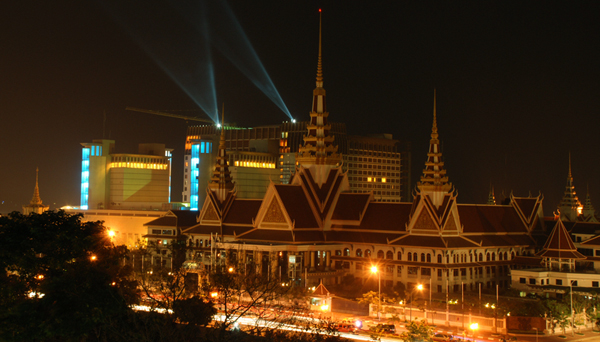Excess is the watchword of the ‘Khmer Riche’, writes Sebastian Strangio

Diamond Island, in Cambodia’s capital Phnom Penh, is serviced by two roads, which snake from the mainland on to the reclaimed island over narrow bridges. On a typical evening, as the Mekong River islet fills up with revellers, both resemble a gleaming river of light, red brake lights flowing one way, white headlights the other. Diamond Island is the playground for Cambodia’s wealthy elite, and the first venue of choice for lavish wedding celebrations.
Cambodian betrothals – like their Indian counterparts – have always been something of an ostentatious affair, but here, in the island’s string of vast hangar-like reception halls, they take on an extra gleam and polish. Luxury cars – Mercedes, Porsches, Lexuses and Escalades – line the fronts of the wedding halls, where wealthy young brides, wreathed in technicolor silks and dripping expensive jewellery, stand alongside their newly-minted husbands, hands pressed together in the traditional gesture of greeting.
Impunity
Devastated by decades of war and upheaval, Cambodia remains a desperately poor country, where human development indices rate among the lowest in the world, and levels of corruption among the highest. Over the past two decades, the country has seen skyrocketing economic growth rates – from 2004 to 2007, its growth rate crept into the double figures, rivalling even that of China – which have spawned a small professional middle-class in Phnom Penh and other urban centres. But much of this growth has taken place in a shadow economy dominated by a tiny ruling elite surrounding Prime Minister Hun Sen, who has maintained a firm grip on power since ousting his rivals in a bloody coup d’état in 1997.
The result, more than a decade after the country’s civil war came to an end, is the emergence of new generation of noveau riche born into vast inherited wealth gleaned from corruption, nepotism and the exploitation of the country’s natural resources. The profligacy of this new demographic is evident everywhere in Phnom Penh, from the fashionable western cafés where wealthy youth chat and joke over iPads and Frappuccinos, to the overpriced nightclubs where bodyguards keep watch as their louche charges ply girlfriends and prostitutes with the pricier brands of imported whisky and cognac.
And then there are the cars: each year, more and more SUVs take to the streets, turning the city’s wide French-built boulevards into growling bottlenecks. No other Asian city can compare with Phnom Penh for the sheer number and variety of luxury vehicles on display, and nowhere else are these juggernauts more prized and fetishised. The country’s 500-riel note even features the miniature image of a Porsche.
A typical Phnom Penh scene features a petite Khmer woman, barely out of her teens, manoeuvring a gold Cadillac Escalade out of a shopping mall’s car park, heedlessly chatting on the phone while traffic backs up behind her. Or the black SUV that roars through Boeung Keng Kang, Phnom Penh’s leafy district, blazing its headlights in contempt at any vehicle that crosses its path.
A key element of this system of laissez faire cronyism is the strong axis linking wealth and impunity. In August 2008, Hun Chea, one of the prime minister’s nephews, ploughed into a motorcyclist in his Escalade, tearing off the man’s arm and leg. He died at the scene. Far from holding Hun Chea to account, local media reported that traffic police avoided the scene, while a squad of military police arrived and removed the car’s number plates. Hun Chea faced no sanction, though he did later pay the motorcyclist’s bereaved family “compensation” of US$4,000 – that apparently being the going price for the life of an ordinary Cambodian.
Late to the party
As with the hedonistic Roaring Twenties, which followed the blood-letting of the Great War, the excesses of the “Khmer Riche” (as one writer has dubbed them) have a reckless, unrestrained quality, as if, having arrived late to the party of emerging Asian nations, they are striving to make up for lost time. They are, after all, the first in several Cambodian generations not to have grown up against a backdrop of poverty, upheaval and war, and they seem determined to make a show of it.
Some hold out hope that these young elites – many, like Hun Sen’s son and heir apparent Hun Manet, educated in the West – will give birth to the country’s next generation of democrats. Or that as new money becomes old, it will be accompanied by a shift in attitudes (in taste of cars, at least, if not in politics). But the excesses and luxuries of the Cambodian high-life may, in the end, prove too much for this generation to resist. Only time will tell whether or not the young and beautiful of Cambodia’s Jazz Age become, like F. Scott Fitzgerald’s famous creations, its damned as well.
[Published in The World Today, February/March 2012]



